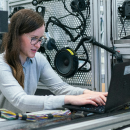
Technology transfer is a part of Astra’s path
In narrating Astra’s activities, we have focused so far on overviews related to two work packages: the first one centered on hardware technologies and the second one that is more oriented towards software.
There is a third work package, as important as the first two, called “Technology Transfer and Impact Management”. It encompasses the strategies designed to manage the transfer of technology, the impact of Astra on the space industry and the possible economic outcomes for the cities involved in the project.
This work package has a budget of 900,000 euros, primarily used to ensure the involvement of highly specialized professionals. Three staff members have been specifically hired for this purpose, in addition to over 30 employees already working within the organizations involved in the partnership.
The work package is structured along three main directions: protection and valorization of intellectual property, supply chain development and spin-off creation, and ensuring the ethical use of new technologies.
According to Kiran Prestia, a legal expert hired within Astra to coordinate the protection, management, and valorization of intellectual and industrial property, technology transfer of expertise is essential to fostering innovation and economic development, particularly in high-tech projects such as those in the space sector.
This process goes beyond the mere transfer of technology. It includes the definition of licensing conditions and the protection of intellectual and industrial property. It also represents a growth opportunity for universities, research institutes, businesses, and investors, stimulating progress and economic innovation.
As Prestia affirms, “At an initial stage, it is crucial to identify and analyze the technologies developed, determine their ownership, creation process, and intended use. Within Astra, confidentiality agreements and conventions have been signed among project partners to ensure alignment with the objectives, timelines, and reporting of the technologies produced.”
Prestia continues, “Following this phase, specific implementation agreements will be signed, detailing roles, responsibilities, and operational procedures for the exploitation and protection of the developed technologies. This ensures compliance with current regulations and guarantees maximum transparency in the management and transfer of results.”
Another key aspect is the development and protection of the results generated by the produced technologies. These are referred to as foreground, meaning the outcomes obtained through research activities, particularly those of original nature that qualify for intellectual property protection. In other words, they represent the intellectual property results achieved during project execution.
These results can be transferred or licensed, either for a fee or free of charge. “It is essential for each project affiliate to promote the valorization of research outcomes and the associated data, ensuring open access as quickly as possible and with minimal restrictions, in accordance with the principles of Open Science and FAIR Data, as well as the specific agreements established among the parties regarding intellectual property management” says Prestia.
In the context of the project, free access to intellectual property results is not merely a formality but a crucial element in fostering synergy among partners. It allows them to integrate their respective expertise and accelerate the development of innovative products.
Formalizing intellectual property management is fundamental to ensuring the proper and transparent transfer of ownership or, alternatively, free access to the results. “If implemented effectively, technology transfer acts as a bridge between research and innovation, transforming scientific results into innovative products and services.” Concludes Prestia, “This process not only generates tangible value for the organizations involved but also strengthens the entire ecosystem, promoting economic growth, sustainability, and competitiveness on a systemic scale.”
The objectives of fostering technological and socio-economic development are among the defining features of the Vitality ecosystem, of which Astra is one of ten spokes. With measurable results and well-defined goals, Astra’s path is still long, but the determination and vision to navigate it are firmly in place.

